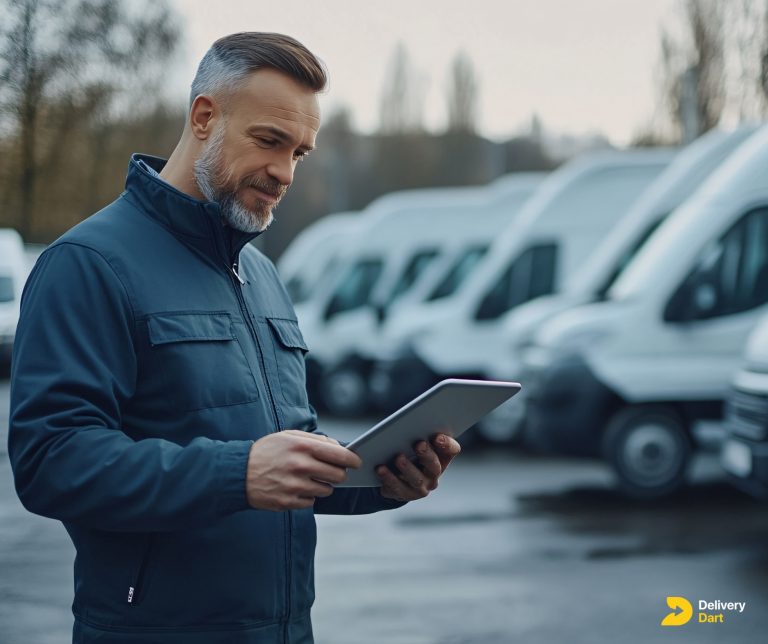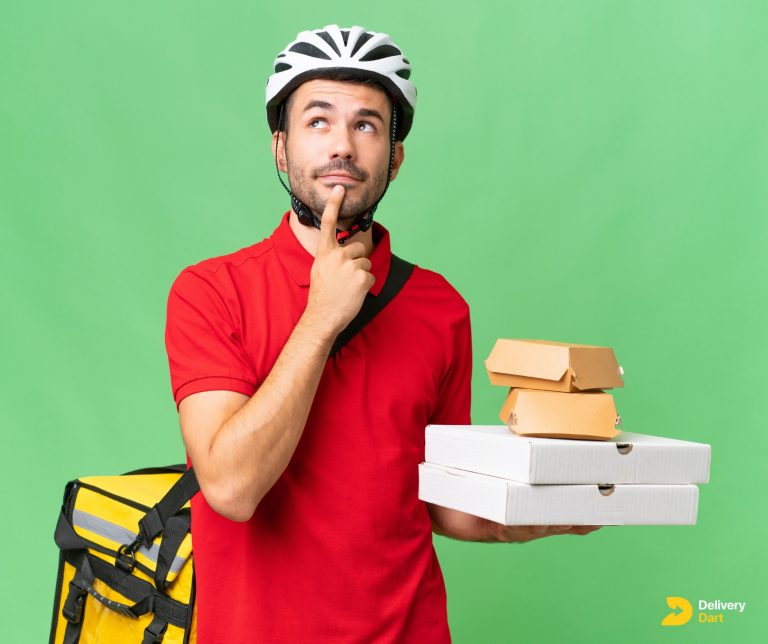Imagine this: It’s Friday night, and the city’s buzzing with hungry people waiting for their favorite meals to arrive at their doorsteps. You’re a food delivery driver, navigating through congested streets, battling the clock to make sure each order is delivered hot and fresh. The pressure is intense, and every minute counts, this is the ultimate delivery driver challenge.
But here’s the thing—while food delivery might seem straightforward, it comes with its own set of challenges that can turn a simple job into a daily grind. From dealing with unpredictable traffic jams to ensuring that customers’ high expectations are met, food delivery drivers are constantly under the gun. And with rising fuel costs and the need to maintain top-notch safety, the job isn’t just about getting from point A to point B anymore.
In 2024, the stakes are even higher. With the surge in online food orders, drivers are facing more demands than ever before. But with every challenge comes an opportunity to improve, adapt, and succeed. Whether you’re a seasoned delivery pro or just starting out, understanding these hurdles—and how to overcome them—can make all the difference in your daily grind. Let’s dive into the top challenges food delivery drivers face today and explore some practical, no-nonsense solutions to keep you ahead of the game.
Challenge 1: Navigating Urban Traffic and Delivery Zones
Navigating through city traffic is a nightmare for anyone, but for food delivery drivers, it’s a daily battle. Picture this: you’re on your way to deliver a piping hot pizza, but the traffic lights seem to conspire against you, and every road is jammed with cars. It’s frustrating, stressful, and worst of all—it eats into your delivery time.
The Challenge:
- Congested Streets: In bustling cities like New York and San Francisco, traffic congestion is more than just an inconvenience. A 2023 study by INRIX found that food delivery drivers in these cities spend up to 25% more time stuck in traffic than other drivers.
- Multiple Delivery Zones: Juggling different delivery zones adds complexity, making it tough to stay on schedule.
Why It Matters:
- Customer Expectations: When you’re stuck in traffic, every minute counts. Customers expect their food to arrive quickly and in perfect condition. A late delivery can lead to unhappy customers and lower tips.
- Increased Stress: Constantly battling traffic not only delays deliveries but also adds stress to an already demanding job.
The Solution:
- Smart Routing Systems: Working smarter, not harder, is key. Leveraging advanced delivery routing systems that use real-time traffic data can be a game-changer.
- Real-Time Traffic Data: These tools can help you find the quickest routes, dodge traffic jams, and keep your deliveries on schedule.
- Predictive Rerouting: Imagine having an app that not only gives you directions but also predicts traffic snarls and reroutes you in real time.
The Benefits:
- Reduced Delays: By staying ahead of traffic with smart tools, you can cut down on delivery delays.
- Happy Customers: On-time deliveries mean satisfied customers, which can lead to better tips and repeat business.
By using advanced navigation tools and staying one step ahead of the traffic, you can turn this daily challenge into just another part of the job. After all, a smooth delivery means happy customers—and more tips in your pocket.
Challenge 2: Meeting Tight Delivery Windows and Customer Expectations
In the fast-paced world of food delivery, time is everything. Customers expect their meals to arrive quickly, often within 30 minutes or less, and anything beyond that can lead to frustration and disappointment. As a food delivery driver, this creates a constant race against the clock, where every second counts.
The Challenge:
- High Customer Expectations: With most food delivery apps promoting rapid delivery times, customers have come to expect their orders to arrive almost instantly. This puts significant pressure on drivers to deliver quickly while maintaining quality.
- Tight Delivery Windows: The promise of fast delivery means drivers often have very little margin for error. Even a small delay can throw off the entire schedule.
Why It Matters:
- Customer Satisfaction: According to a report by the National Restaurant Association, 70% of customers will abandon a food delivery service after experiencing just one late delivery. This highlights how critical it is to meet delivery expectations consistently.
- Balancing Speed with Safety: While speed is crucial, it shouldn’t come at the expense of safety. Rushing to meet tight deadlines can increase the risk of accidents and mistakes.
The Solution:
- Realistic Delivery Timeframes: To ease the pressure, companies should implement more realistic delivery timeframes that consider traffic, preparation time, and other variables. This helps drivers manage their time better without compromising on safety.
- Technology to the Rescue: Tools like scheduling software can play a vital role in helping drivers manage multiple orders efficiently. These tools predict and manage delivery times more accurately, ensuring that drivers can meet customer expectations without the added stress.
- Efficient Order Management: By using advanced scheduling and route optimization, drivers can better balance their deliveries, ensuring that each order arrives on time and in great condition.
The Benefits:
- Reduced Stress: With more manageable delivery windows and the right tools at your disposal, the job becomes less stressful, allowing you to focus on delivering excellent service.
- Improved Customer Satisfaction: Meeting delivery expectations leads to happier customers, which can translate into better reviews, repeat business, and higher tips.
By adopting realistic delivery expectations and using technology to manage orders, you can strike the perfect balance between speed and safety. This not only keeps your customers happy but also makes your job more enjoyable and rewarding.
Challenge 3: Ensuring Food Safety and Maintaining Quality
When it comes to food delivery, nothing matters more to customers than receiving their meal hot, fresh, and just as the restaurant intended. But ensuring that food maintains its quality during transit is no small feat, especially when you’re juggling multiple deliveries or covering longer distances.
The Challenge:
- Maintaining Temperature: One of the biggest challenges is keeping food at the right temperature—hot items need to stay hot, and cold items need to stay cold. This becomes even more difficult when you’re making multiple stops or dealing with heavy traffic.
- Preserving Presentation: Beyond just temperature, the presentation of the food also matters. No one wants to receive a meal that looks like it’s been through a spin cycle. Ensuring that food remains intact and appetizing during delivery is crucial for customer satisfaction.
Why It Matters:
- Customer Satisfaction: A survey by Technomic revealed that 62% of consumers are unlikely to reorder from a food delivery service if their food arrives cold or in poor condition. This highlights the importance of maintaining food quality from the restaurant to the customer’s doorstep.
- Brand Reputation: Consistently delivering food that meets or exceeds customer expectations can enhance the reputation of both the delivery service and the restaurant. On the other hand, poor food quality can lead to negative reviews and lost business.
The Solution:
- Invest in Insulated Delivery Bags: To ensure that food stays at the right temperature, investing in high-quality insulated delivery bags is essential. These bags help keep hot foods hot and cold foods cold, even during longer trips.
- Proper Packing Techniques: Using proper packing techniques can also make a big difference. For example, keeping hot and cold items separate, securing lids, and placing items in the bag in a way that prevents them from shifting during transit can help maintain both temperature and presentation.
- Careful Handling: Treating each delivery as if it were your own meal ensures that the food arrives in the best possible condition. Being mindful of how the food is packed and handled during delivery can prevent spills, leaks, and other issues that could compromise quality.
The Benefits:
- Happier Customers: When food arrives fresh and hot, customers are more likely to be satisfied with their order, leading to better reviews, repeat business, and higher tips.
- Enhanced Reputation: Consistently delivering high-quality meals can boost your reputation and help you stand out in a competitive market.
By focusing on food safety and quality during delivery, you can ensure that every order arrives in perfect condition, keeping customers happy and coming back for more.
Challenge 4: Managing Rising Fuel and Vehicle Maintenance Costs
For food delivery drivers, the road is both their livelihood and their biggest expense. With fuel prices on the rise and the constant need for vehicle maintenance, keeping costs under control is becoming increasingly difficult, especially for those working as independent contractors who shoulder these expenses on their own.
The Challenge:
- Rising Fuel Costs: Over the past two years, the cost of fuel has surged dramatically. According to the U.S. Energy Information Administration, fuel prices have increased by 20%, making every mile you drive more expensive.
- Maintenance Expenses: Beyond fuel, regular vehicle maintenance is another significant cost. From oil changes to tire replacements, these expenses can quickly add up, cutting into your earnings and making it harder to stay profitable.
Why It Matters:
- Impact on Earnings: For many food delivery drivers, rising operational costs can eat into profits, leaving them with less money at the end of the day. Every dollar spent on fuel or repairs is a dollar not going into your pocket.
- Job Viability: If costs continue to rise unchecked, it could make food delivery less viable as a full-time job, particularly for independent contractors who don’t receive support from an employer.
The Solution:
- Fuel Efficiency: Driving smarter can help reduce fuel costs. Simple changes like maintaining a steady speed, avoiding rapid acceleration, and planning routes more efficiently can improve fuel economy.
- Vehicle Maintenance Discounts: Some delivery companies offer maintenance discounts or partnerships with local auto shops, making it more affordable for drivers to keep their vehicles in top shape.
- Fuel Subsidies: Delivery companies can also offer fuel subsidies to help offset the rising costs. These subsidies can make a big difference in helping drivers manage their expenses and keep more of their earnings.
The Benefits:
- Lower Operational Costs: By taking advantage of discounts, subsidies, and fuel-efficient driving practices, you can reduce your overall expenses and keep more of what you earn.
- Increased Profitability: With lower costs, your earnings will go further, making food delivery a more sustainable and profitable job in the long run.
By managing fuel and maintenance costs effectively, you can ensure that your time on the road is both productive and profitable. Taking advantage of available resources and driving smarter can help you stay ahead, even as expenses rise.
Challenge 5: Navigating Health and Safety Risks
Being a food delivery driver isn’t just about getting from point A to point B—it’s also about staying safe while doing so. From dodging reckless drivers to braving bad weather, the job comes with its share of health and safety risks that can make each delivery more dangerous than it seems.
The Challenge:
- Road Safety: Food delivery drivers are constantly on the move, often navigating through heavy traffic, unfamiliar neighborhoods, and less-than-ideal road conditions. Unfortunately, this puts them at a higher risk of road accidents. According to the Bureau of Labor Statistics, delivery drivers, including those in the food sector, are among the occupations with the highest rates of work-related injuries.
- Weather Hazards: Whether it’s rain, snow, or extreme heat, drivers have to keep going no matter what the weather throws at them. These conditions not only make driving more dangerous but can also lead to physical stress and exhaustion.
- Physical Demands: The job requires long hours on the road and repetitive tasks, such as getting in and out of the car or carrying heavy bags, which can take a toll on a driver’s body over time.
Why It Matters:
- Personal Safety: The safety risks associated with food delivery are significant. Accidents or health issues not only impact the driver but can also lead to lost income, medical bills, and long-term health problems.
- Job Sustainability: Without proper safety measures, the physical demands and risks of the job can lead to burnout or force drivers to leave the profession altogether.
The Solution:
- Safety Training: Companies should provide comprehensive safety training that covers defensive driving techniques, how to handle hazardous weather conditions, and ways to reduce the risk of injury during deliveries. This training can equip drivers with the knowledge they need to stay safe on the road.
- Health and Wellness Resources: Access to health and wellness resources, such as regular health check-ups, ergonomic tools for handling deliveries, and mental health support, can help drivers manage the physical and emotional stresses of the job.
- Protective Gear: Companies should also provide or recommend protective gear, such as reflective vests for nighttime deliveries and weather-appropriate clothing, to help drivers stay safe and comfortable during their shifts.
The Benefits:
- Improved Safety: With the right training and resources, drivers can significantly reduce their risk of accidents and injuries, making the job safer and more sustainable.
- Better Health: Access to health and wellness resources helps drivers take care of their physical and mental health, reducing burnout and improving overall job satisfaction.
By prioritizing safety and health, food delivery drivers can protect themselves from the risks that come with the job. With the right support, they can stay safe on the road and continue delivering great service without compromising their well-being.
Driving Towards a Brighter Future
As a food delivery driver, the road is filled with challenges, from navigating traffic and meeting tight deadlines to ensuring the safety of both yourself and the food you deliver. But with every challenge comes an opportunity to learn, grow, and improve. By leveraging the right tools, like advanced routing systems and safety training, you can turn these daily hurdles into just another part of the job—one that you’re more than equipped to handle.
And remember, you’re not alone on this journey. Services like DeliveryDart are here to support you every step of the way, offering smart solutions to help you stay ahead of the game. Whether it’s optimizing your routes, managing your deliveries more efficiently, or providing the resources you need to stay safe and healthy, the future of food delivery is bright—and so is yours.
So, buckle up, stay focused, and keep delivering excellence with DeliveryDart. With the right mindset and the right tools, there’s nothing you can’t overcome on the road ahead. Here’s to more smooth deliveries, happy customers, and a thriving career on the move!




